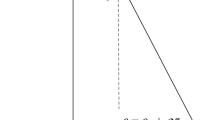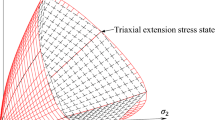Abstract
This study introduces a methodology to solve plane strain stability problems in rock mechanics, following the generalized Hoek and Brown yield criterion, by employing the lower bound finite elements limit analysis in conjunction with the power cone programming. The efficacy of the proposed approach has been demonstrated by solving three different types of stability problems: (1) finding the bearing capacity of strip footings on rock media, (2) assessing the stability of finite rock slopes, and (3) the stability analysis of unlined rectangular tunnels in rock mass. In all the cases, the results obtained from the analysis have been compared thoroughly with that computed using (1) nonlinear programming, and (2) semi-definite programming technique. The present approach has been found to be computationally very robust and it generates very accurate solutions.











Similar content being viewed by others
Abbreviations
- \(\sigma_{1}\) :
-
Major principal stress
- \(\sigma_{3}\) :
-
Minor principal stress
- \(\sigma_{\text{ci}}\) :
-
Uniaxial compressive strength
- \(m_{\text{b}}\) :
-
Hoek–Brown material constant
- \(m_{i}\) :
-
Hoek–Brown material constant
- s :
-
Hoek–Brown material constant
- α :
-
Hoek–Brown material constant
- GSI:
-
Geological strength index
- D :
-
Disturbance factor
- \({\mathcal{K}}\) :
-
Cone
- \({\mathcal{K}}^{*}\) :
-
Dual cone
- \({\Re }^{n}\) :
-
n-Dimensional real space
- \({\Re }^{m \times n}\) :
-
Real matrices of size m\(\times\)n
- \(Q^{n}\) :
-
n-Dimensional quadratic cone
- \(Q_{r}^{n}\) :
-
n-Dimensional rotated quadratic cone
- \(P_{n}^{\beta}\) :
-
n-Dimensional power cone
- \({\mathbf{S}}^{n}\) :
-
Set of \(n \times n\) symmetric matrices
- \({\mathbf{S}}_{ + }^{n}\) :
-
Set of \(n \times n\) positive definite matrices
- \(\varvec{\sigma}\) :
-
Stress tensor
- \(\lambda_{\hbox{max} }\) :
-
Auxiliary variable
- \(\lambda _{{\min }}\) :
-
Auxiliary variable
- t :
-
Auxiliary variable
- \(\sigma_{x}\) :
-
Normal stress on x-plane
- \(\sigma_{y}\) :
-
Normal stress on y-plane
- \(\tau_{xy}\) :
-
Shear stress on x-plane in y-direction
- \(\varvec{c}\) :
-
Vector which contains the objective function
- \(\bar{\varvec{\sigma }}\) :
-
Global unknown vector
- NN :
-
Number of nodes
- \({\mathbf{A}}_{\text{equi}}\) :
-
Matrix containing the left-hand side of all the equilibrium equations
- \({\mathbf{A}}_{\text{dis}}\) :
-
Matrix containing the left-hand side of all the discontinuity equations
- \({\mathbf{A}}_{\text{bc}}\) :
-
Matrix containing the left-hand side of all the boundary conditions
- \({\mathbf{b}}_{\text{equi}}\) :
-
Vector containing the right-hand side of all the equilibrium equations
- \({\mathbf{b}}_{\text{dis}}\) :
-
Vector containing the right-hand side of all the discontinuity equations
- \({\mathbf{b}}_{\text{bc}}\) :
-
Vector containing the right-hand side of all the boundary conditions
- B :
-
Width of foundation
- \(Q_{\text{u}}\) :
-
Maximum vertical load
- \(N_{\sigma }\) :
-
Bearing capacity factor of strip footing in weightless media
- \(N_{\sigma \gamma }\) :
-
Bearing capacity factor of strip footing
- \(q_{\text{u}}\) :
-
Ultimate bearing pressure
- γ :
-
Unit weight of rock mass
- L :
-
Parameter which defines the boundary
- H :
-
Parameter which defines the boundary
- p :
-
Parameter which defines the state of stress
- q :
-
Parameter which defines the state of stress
- β :
-
Slope angle
- \(N_{\text{s}}\) :
-
Stability number for slope
- h :
-
Height of tunnel
- w :
-
Width of tunnel
- \(N_{\text{t}}\) :
-
Stability number for tunnel
References
Alizadeh F (1995) Interior point methods in semidefinite programming with applications to combinational optimization. SIAM J Optim 5(1):13–51
Alizadeh F, Goldfarb D (2003) Second-order cone programming. Math Progr Ser B 95(1):3–51
Alzoubi AK, Martin CD, Cruden DM (2010) Influence of tensile strength on toppling failure in centrifuge tests. Int J Rock Mech Min Sci 47:974–982
Andersen ED, Roos C, Terlaky T (2003) On implementing a primal-dual interior-point method for conic quadratic optimization. Math Progr 95(2):249–277
Boyd S, Vandenberghe L (2004) Convex optimization. Cambridge University Press, Cambridge
Chakraborty M, Kumar J (2015) Bearing capacity of circular footings over rock mass by using axisymmetric quasi lower bound finite element limit analysis. Comput Geotech 70:138–149
Cundall PA (1971) A computer model for simulating progressive large scale movements in blocky rock systems. In: Proceedings of the international symposium on rock fracture, Nancy, October 1971. International society for rock mechanics (ISRM), 1, paper no. II–8, pp 129–136
Hoek E (1983) Strength of jointed rock masses. Geotechnique 33(3):187–223
Hoek E (2007) Practical rock engineering. http://www.rocscience.com
Hoek E, Brown ET (1980) Empirical strength criterion for rock masses. J Geotech Eng Div 106(GT9):1013–1035
Hoek E, Carranza-Torres C, Corkum B (2002) Hoek–Brown failure criterion 2002 edition. In: Proceedings of the 5th North American Rock mechanics symposium and the 17th Tunnelling Association of Canada Conference: NARMS-TAC, Toronto
Krabbenhoft K, Lyamin AV, Sloan SW (2007) Formulation and solution of some plasticity problems as conic programs. Int J Solids Struct 44(5):1533–1549
Kumar J, Mohapatra D (2017) Lower-bound finite elements limit analysis for Hoek–Brown materials using semidefinite programming. J Eng Mech 143(9):04017077
Kumar J, Mohapatra D (2018) Closure to lower bound finite elements limit analysis for Hoek–Brown materials using semidefinite programming by J Kumar and D Mohapatra. J Eng Mech 144(7):07018002
Li AJ, Merifield RS, Lyamin AV (2008) Stability charts for rock slopes based on the Hoek–Brown failure criterion. Int J Rock Mech Min Sci 45(5):689–700
Li LC, Tang CA, Zhu WC, Liang ZZ (2009) Numerical analysis of slope stability based on the gravity increase method. Comput Geotech 36:1246–1258
Lian JJ, Li Q, Deng XF, Zhao GF, Chen ZY (2018) A numerical study on toppling failure of a jointed rock slope by using the distinct lattice spring model. Rock Mech Rock Eng 51(2):513–530
Makrodimopoulos A, Martin CM (2006) Lower bound limit analysis of cohesive frictional materials using second-order cone programming. Int J Numer Methods Eng 66(4):604–634
Merifield RS, Lyamin AV, Sloan SW (2006) Limit analysis solutions for the bearing capacity of rock masses using the generalized Hoek–Brown yield criterion. Int J Rock Mech Min Sci 43(6):920–937
Mohapatra D, Kumar J (2019a) Smoothed finite element approach for kinematic limit analysis of cohesive frictional materials. Eur J Mech A Solids 76:328–345
Mohapatra D, Kumar J (2019b) Collapse loads for rectangular foundations by three dimensional upper bound limit analysis using radial point interpolation method. Int J Numer Anal Methods Geomech 43(2):641–660
MOSEK ApS (2019) The MOSEK optimization tools manual version. http://www.mosek.com
Nesterov YE, Todd MJ (1998) Primal-dual interior-point methods for self-scaled cones. SIAM J Optim 8(2):324–364
Shi GH, Goodman RE (1985) Two dimensional discontinuous deformation analysis. Int J Numer Anal Meth Geomech 9(6):541–556
Sloan SW (1988) Lower bound limit analysis using finite elements and linear programming. Int J Numer Anal Methods Geomech 12:61–77
Sloan SW (2013) Geotechnical stability analysis. Géotechique 63(7):531
Sturm JF (1999) Using SeDuMi 1.02, a MATLAB toolbox for optimization over symmetric cones. Optim Methods Soft 11(1–4):625–653
Suchowerska AM, Merifield RS, Carter JP, Clausen J (2012) Prediction of underground cavity roof collapse using the Hoek–Brown failure criterion. Comput Geotech 44:93–103
Swan CC, Seo Y (1999) Limit state analysis of earthen slopes using dual continuum/FEM approaches. Int J Numer Anal Methods Geomech 23(12):1359–1371
Tang C, Toh K, Phoon K (2014) Axisymmetric lower-bound limit analysis using finite elements and second order cone programming (SOCP). J Eng Mech 140(2):268–278
Tütüncü RH, Toh KC, Todd MJ (2003) Solving semidefinite-quadratic-linear programs using SDPT3. Math Progr 95(2):189–217
Ukritchon B, Keawsawasvong S (2018) Three-dimensional lower bound finite element limit analysis of Hoek–Brown material using semidefinite programming. Comput Geotech 104:248–270
Ukritchon B, Keawsawasvong S (2019) Stability of unlined square tunnels in Hoek–Brown rock masses based on lower bound analysis. Comput Geotech 105:249–264
Zhang R, Chen G, Zou J, Zhao L, Jiang C (2019) Study on roof collapse of deep circular cavities in jointed rock masses using adaptive finite element limit analysis. Comput Geotech 111:42–55
Zienkiewicz OC, Humpheson C, Lewis RW (1975) Associated and nonassociated viscoplasticity in soil mechanics. Géotechnique 25(4):671–689
Author information
Authors and Affiliations
Corresponding author
Additional information
Publisher's Note
Springer Nature remains neutral with regard to jurisdictional claims in published maps and institutional affiliations.
Appendix: Implementation of the PCP in MOSEK
Appendix: Implementation of the PCP in MOSEK
The present investigation utilizes the optimization toolbox: MOSEK in MATLAB since it can handle the PCP which is found to be robust and computationally very efficient (Makrodimopoulos and Martin 2006; Ukritchon and Keawsawasvong 2018; Mohapatra and Kumar 2019a). To solve the PCP in MOSEK, the input needs to be specified in a particular way. The objective function, as given in Eq. (22), is defined by the command ‘prob.c’. The matrices containing inequality or equality constraints are defined with ‘prob.a’ command. The lower and upper bounds of the constraints are specified by ‘prob.blc’ and ‘prob.buc’, respectively. The corresponding bounds on the variables are defined by ‘prob.blx’ and ‘prob.bux’. The cones are prescribed using four different cell arrays: ‘prob.cones.type’, ‘prob.cones.conepar’, ‘prob.cones.sub’ and ‘prob.cones.subptr’. The array ‘prob.cones.type’ specifies the type of cone and it takes the command (1) ‘res.symbcon.MSK_CT_QUAD’ for the second-order cone, (2) ‘res.symbcon.MSK_CT_RQUAD’ for the rotated quadratic cone, and (3) ‘res.symbcon.MSK_CT_PPOW’ for the power cone. The value of the power term in the power cone is specified by ‘prob.cones.conepar’. The variables related to a particular cone are specified by ‘prob.cones.sub’ and the change in the cone is indicated in ‘prob.cones.subptr’. The optimal solution of the objective function is obtained through ‘res.sol.itr.pobjval’ command. The primal as well as dual optimal solutions of the variables are finally reported in ‘res.sol.itr.xx’ and ‘res.sol.itr.y’, respectively.
Rights and permissions
About this article
Cite this article
Kumar, J., Rahaman, O. Lower Bound Limit Analysis Using Power Cone Programming for Solving Stability Problems in Rock Mechanics for Generalized Hoek–Brown Criterion. Rock Mech Rock Eng 53, 3237–3252 (2020). https://doi.org/10.1007/s00603-020-02099-y
Received:
Accepted:
Published:
Issue Date:
DOI: https://doi.org/10.1007/s00603-020-02099-y




